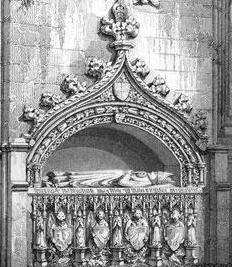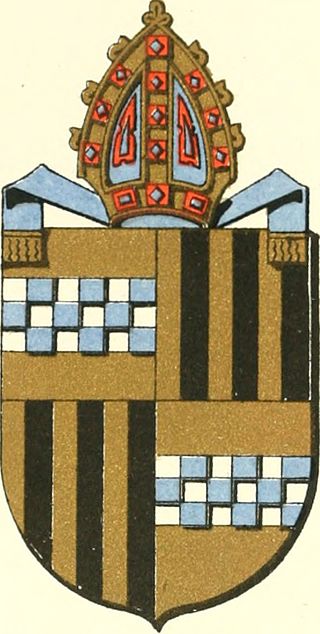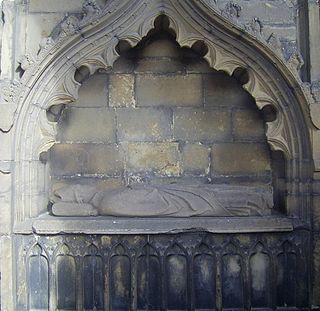Related Research Articles

Robert de Cardeny was a late 14th and early 15th century Scottish cleric. He was the son of one John Cardeny, and brother of the royal mistress Mariota de Cardeny. His early career is obscure. In 1378–80, King Robert II of Scotland petitioned the Pope for a canonry in the diocese of Moray for one Robert de Cardun, despite the fact that the latter already held canonries and prebends in the diocese of Dunblane and Dunkeld. This Robert de Cardun was both a member of King Robert's household and a student at the University of Paris. Robert had graduated from Paris in 1381 as Licentiate. In 1392 he was a receiver of the "English Nation" at Paris and custodian of the Nation's seal. In 1394 Robert was still in Paris, now as Master Robert de Cardeny
Domhnall MacNeachdainn was a 15th-century Dean and Bishop of Dunkeld. He was the nephew of Robert de Cardeny, Bishop of Dunkeld, by Robert's sister, Mairead (Mariota). The latter was also the mistress of King Robert II of Scotland. His father was probably a chief of the MacNeachdainn (MacNaughton) kindred. Domhnall was university trained, and by 1431 had a M. A. and a Doctorate in Decrees. He had been Dean of Dunkeld since the year 1420. He was one of the commissioners of the Scottish king at the Council of Basel in 1433. In 1437, Bishop Robert de Cardeny died and Domhnall the Dean was elected as his replacement. Domhnall died sometime in the year 1440. Since Alexander Myln at least it has been thought that he sought confirmation from the Papacy and died en route, but direct evidence for this is lacking.
John de Ralston was a 15th-century Scottish bishop and administrator. He was regarded as illegitimate, although today his parents are not known. Ralston appears in the records for the first time in 1426, where he is chaplain and secretary to Archibald Douglas, 5th Earl of Douglas. He retained this position on the death of Douglas in 1439. Between 1429 and 1443 he served as the fourth provost of Bothwell Collegiate Church, the home church of the Douglas earls. On 26 November 1445 he became dean of the diocese of Dunkeld.
Alexander Inglis was a Scottish cleric and royal clerk. He was the son of one George Inglis and his wife Margeret. At some point in his life he had attended university and obtained a Licentiate in Decrees. In 1477 he became Dean of the diocese of Dunkeld, and in 1480 became Archdeacon of St Andrews. On 17 September 1483, after the death of Bishop James Livingston, he was elected to succeed the latter as Bishop of Dunkeld. Inglis ran into difficulty on 22 October, when the Chancellor of the diocese of Aberdeen, George Brown, was also provided as Bishop of Dunkeld. Inglis was styled Bishop-elect in Scotland until 1485, but on 13 June 1484, Brown had been consecrated at the Papal see. Inglis continued to hold his previous posts as Archdeacon and Dean until his death in 1496.
George Brown was a late 15th-century and early 16th-century Scottish churchman. He first appears on record in 1478 as the rector of the church of Tyningham, and is called a clerk of the diocese of Brechin. In 1482, he was selected to be Chancellor of the diocese of Aberdeen.

Andrew Stewart was a 16th-century Scottish noble and cleric. He was a legitimate son of John Stewart, 1st Earl of Atholl and Eleanor Sinclair, daughter of William Sinclair, Earl of Orkney. His paternal grandmother was Joan Beaufort, former queen-consort of Scotland. Andrew chose an ecclesiastical career, held a canonry in Dunkeld Cathedral and was rector of Blair parish church, a church under the control of the earls of Atholl.

Robert Cockburn was a 16th-century Scottish diplomat and cleric.
Robert Crichton was a 16th-century Scottish Catholic cleric.
Ingram Lindsay [Ingeram de Lindesay], Doctor in Canon Law, was a 15th-century Scottish cleric. Despite being of illegitimate birth - one of several sons of an unmarried nobleman and an unmarried woman - he nevertheless managed in the end to pursue a successful ecclesiastical career.
Alexander de Kininmund was a 14th-century Scottish churchman. The first mention of Alexander occurs when, as a canon of Dunkeld he is one of three ambassadors sent by King Robert I of Scotland to Avignon in 1320. The purpose of this embassy was to present a letter to Pope John XXII known as the Declaration of Arbroath. As a papal chaplain and lawyer, he was well qualified to argue the Scottish cause, and Barrow makes a strong case that he was, in fact the author of the document.

John de Winchester was a 15th-century English cleric who distinguished himself as an administrator and bishop in Scotland. Winchester was a student of canon law from 1418, graduating with a bachelorate in 1421.
Alexander Bur was a 14th-century Scottish cleric. It is highly possible that Bur came from somewhere in or around Aberdeenshire, although that is not certain and is only based on the knowledge that Aberdeenshire is where other people bearing his surname come from in this period. He entered the service of King David II of Scotland sometime after 1343, perhaps as a member of David's exiled court at Château Gaillard. Although Alexander by this point in time already held prebends in both the bishopric of Aberdeen and the bishopric of Dunkeld, on that date King David petitioned Pope Clement VI for another canonry in the bishopric of Moray. Alexander had become a royal clerk and had obtained a Licentiate in Canon Law by 1350. By the latter date, upon the death of Adam Penny, Archdeacon of Moray, Alexander himself became Archdeacon.
Alexander Vaus [Vause, de Vaus] was a late 14th century and 15th century Scottish prelate. Said to have been the younger son of one Patrick Vaus, he apparently held "church livings" in Galloway as early as 1421.
Ingram de Ketenis was a medieval cleric from Angus in Scotland.
Thomas de Buittle [Butil, Butill, Butyll, Butyl, Bucyl] was a Scottish prelate, clerk and papal auditor active in the late 14th and early 15th centuries. Probably originating in Galloway, Scotland, Thomas took a university career in canon law in England and France, before taking up service at the court of Avignon Pope Benedict XIII. He obtained a number of benefices in the meantime, including the position of Archdeacon of Galloway, and is the earliest known and probably first provost of the collegiate church of Maybole. The height of his career came however when the Pope provided him to the bishopric of Galloway, a position he held from 1415 until his death sometime between 1420 and 1422.
Ninian Spot [de Spot] was a royal clerk and prelate in the 15th century Kingdom of Scotland. He spent much of his youth at university, eventually obtaining Master's Degree.
Thomas Tulloch [de Tulloch] was a prelate active in the Kingdom of Scotland in the 15th century. A letter of Pope Martin V in 1429 claimed that he was "of a great noble race by both parents". Robert Keith believed that he had the surname "Urquhart", but that is not supported by the contemporary evidence and is probably spurious.
John Bullock O.S.A. was an Augustinian canon and prelate active in the 15th century Kingdom of Scotland. While earning a university degree between 1409 and 1417, Bullock gained several benefices in Scotland, and claimed the headship of St Andrews Cathedral Priory before becoming Bishop of Ross in 1418. He held the latter position until his death, which occurred in either 1439 or 1440.
Thomas de Rossy was a fourteenth-century Scottish prelate. He appears in the historical record for the first time in 1331, when Pope John XXII provided him to succeed Bernard as Bishop of the Isles. At this stage, the papal sources name him as a canon of Dunkeld Cathedral.
George Shoreswood or Schoriswood, was a prelate active in the Kingdom of Scotland during the 15th century. He appears to have been of English-speaking origin, from the family of Bedshiel in Berwickshire.
References
- Dowden, John, The Bishops of Scotland, ed. J. Maitland Thomson, (Glasgow, 1912)
- Watt, D.E.R., Fasti Ecclesiae Scoticanae Medii Aevi ad annum 1638, 2nd Draft, (St Andrews, 1969)